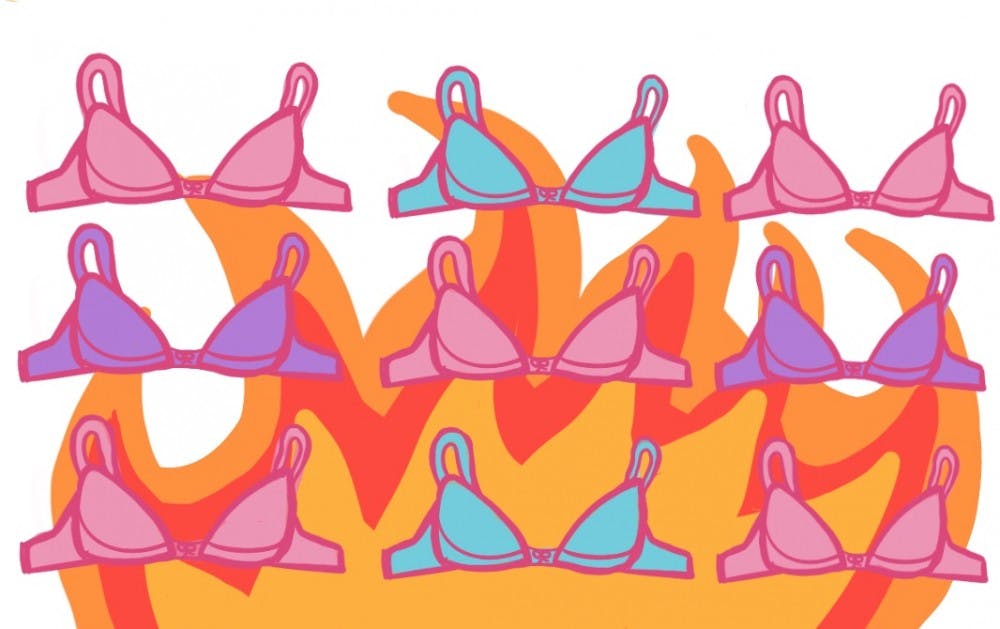Women’s bodies have been endlessly hypersexualized, and the female breast, more specifically the nipple, has continuously been an example of this blatant objectification.
The term “bra-burning feminist” was used to describe women who protested in front of the Miss America pageant by throwing what they referred to as “instruments of female torture," such as bras, lipstick and high heels into trash barrels they labeled "Freedom Trash Cans."
The protest's organizers claim that the literal burning of the items never happened, but local news reports from that day claim otherwise.
While the term “bra-burning feminist” has dwindled, the phrase's message is still alive today in the Free the Nipple movement.
The objectification of a woman's body has led to something as simple as a nipple to become an image of sex, obscenity and something risqué; however, this should not be the case. The female nipple is not a symbol of obscenity but a symbol of life.
“The tip of the nipple contains several hole openings allowing for milk to flow through during lactation," according to Blausen Medical. "The primary function of female breasts is to produce milk in order to nourish an infant.”
While the purpose of women's nipple's is to feed babies, their sexualization has led countless media sites to impose regulations regarding photographs containing a woman's nipple. Some will even remove these photos for inappropriate content — some going as far as restricting users' images within their list of rules.
Instagram's community guidelines ban the posting of nudity on the app, including that of female nipples, "but photos of post-mastectomy scarring and women actively breastfeeding are allowed,” states the policy.
It's an uncalled for over-sexualization which has been hardwired into society that has led to women's nipples being viewed as borderline pornographic and men's nipples being viewed as an everyday norm.
Even breast cancer campaigns are noticing how this affects how breast cancer is viewed, and "sexy" campaigns that focus on preserving a woman's breast rather than her life are rising in popularity.
According to Breast Cancer Action's website, “(These campaigns) objectify women, making breast cancer awareness all about one (highly sexualized) body part instead of women’s complex and diverse experiences with breast cancer.”
This shows how deeply rooted the objectification of women is. Women who support movements like Free the Nipple are not simply fighting for the right to walk around topless, but are also raising awareness of the importance behind desexualizing women's bodies.
Mako Ward, an instructor of women’s and gender studies at ASU, said that there is a trend for women to want agency over their bodies.
“I think that the Free the Nipple movement represents that desire to have the same level of freedom to display the nude body in the same way that men do,” Ward said. “I also think that, from my understanding of the movement, is that it's not just about the freedom to expose the breast but to breakdown and demystify what the breast represents in American culture with respects to heteronormative sexual desire.”
Fort Collins, Colo. recently made strides in freeing the nipple. On Feb. 15, the federal 10th Circuit Court of Appeals lifted the ban of women going topless in public, ruling in favor of activists from Free the Nipple.
According to an article by USA Today, attorney Andy McNulty said, “The court ruled that ordinances that target a group based on gender — such as banning women specifically from going topless, while allowing men to do so — is a violation of the equal protections clause of the U.S. Constitution.”
Colorado is setting the precedent for other states by giving control back to women in regards to their bodies. Currently in Arizona, according to Title 13. Criminal Code § 13-1402, a woman may face jail time if “she exposes the areola or nipple of her breast or breasts and another person is present, and the defendant is reckless about whether the other person, as a reasonable person, would be offended or alarmed by the act.”
This law is just another obstacle in place to control a woman’s body and sexuality. If all states lifted a ban on female breasts, it is highly unlikely one would constantly see women walking around topless. But women should be able to free the nipple if they want to.
After all, wouldn’t it be nice to get rid of some tan lines without the risk of going to jail?
Reach the columnist at psaso@asu.edu and follow @paytonsaso on Twitter.
Editor’s note: The opinions presented in this column are the authors’ and do not imply any endorsement from The State Press or its editors.
Want to join the conversation? Send an email to opiniondesk.statepress@gmail.com. Keep letters under 500 words and be sure to include your university affiliation. Anonymity will not be granted.
Like The State Press on Facebook and follow @statepress on Twitter.




